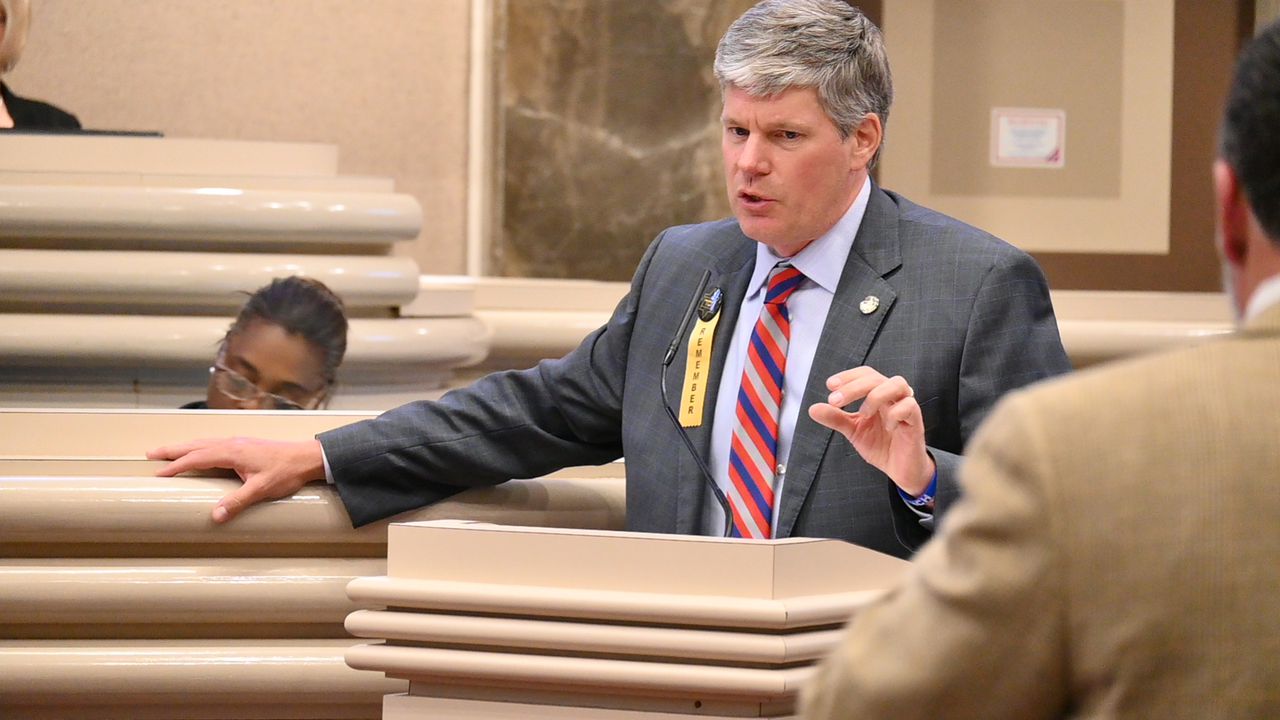Alabama not increasing film tax incentive to be more competitive with Louisiana, Georgia
Alabama lawmakers will not be expanding its film tax incentive program this year under legislation introduced earlier this month that would have put the state’s program on par with Louisiana by 2026.
Under HB429, the state’s film tax credit cap would have increased gradually from its current $20 million to $65 million at the end of fiscal 2024, $110 million at the end of fiscal year 2025, and $150 million by the end of fiscal year 2026.
The state’s fiscal years end on September 30.
Related content:
- After Oscar attention, will Alabama increase its film tax incentive?
- That’s a wrap? Repeal of Alabama’s film tax credit on hiatus
“We’ll revisit that at a later day,” said state Rep. Jamie Kiel, R-Russellville, during a House committee discussion about the proposed changes under HB429 that initially called for an increase in the incentive cap, or the amount of tax credits that can be issued to qualified film production companies in Alabama.
Kiel announced the cap increases were being removed from an amended version of the bill. The only thing that remains in the legislation are some definition changes and the addition of music albums and virtual reality productions to what are qualified for a film tax credit.
Kiel said the focus on Alabama Gov. Kay Ivey’s “Game Plan” legislation was among the reasons why investing more state money on tax incentives was not being pursued this spring.
The Game Plan, signed into law on April 20, includes four pieces of legislation that – among other things – extends the Alabama Jobs Act and Growing Alabama tax credit program to 2028. Both programs were passed in 2015 and were set to expire in July. Lawmakers have said the Jobs Act has helped the state recruit companies that have invested $22 billion and created 40,000 jobs.
Alabama Commerce Secretary Greg Canfield said the passage of the four “Game Plan” bills was his agency’s priority this spring, and not expanding the film tax credit.
“The Alabama Department of Commerce continues to support the recruitment of film and entertainment projects across the state under our current statutory authority to do so,” Canfield said. “While HB429 is not a priority of Commerce for this session, we will continue to evaluate the bill as it is amended and consult with the Legislature and industry.”
Definition changes
Alabama’s film tax credits remain the same under HB429. The state’s credit, as it was defined in the original 2009 law, is a rebate to production companies: 25% rebate is offered on expenditures incurred in Alabama, 35% of payroll to Alabama residents.
The rebate is allowed to be used to offset Alabama income tax liability of the production company. If the amount of the rebate exceeds the production company’s Alabama income tax liability, then the excess will be refunded to the company.
The income tax break is the most popular portion of the incentive. A production has to spend a minimum of $500,000 to qualify for the tax credit but must not exceed $20 million.
Since 2018, the state provided 81 productions with tax credits, including 14 last year with a combined expenditure of $73 million in Alabama, according to information provided by the Department of Commerce.
Kiel said HB429 will be completely amended to the point where only a few changes to definitions within the original law — the Entertainment Industry Incentive Act of 2009 – remain.
Highlights include:
- Replaces “entertainment” with “film and music” to describe the general overall industry eligible to receive the tax credit.
- Adds music albums, entertainment and educational content that incorporates virtual reality or augmented reality or virtual reality film production. Augmented reality – such as Pokemon Go or Snapchat – superimposes computer-generated image on a user’s view of the real world.
- Includes language referencing the success Georgia has had in attracting large film productions since Alabama passed its incentives in 2009.
- Adds the definition of a “qualified production facility” that includes, among other things, a 5,000 square foot office space for film productions, a 4,000 square foot climate-controlled enclosed storage for costumes, and soundproof stage facilities with a minimum ceiling height of 30 feet.
- Defines a “historic location” specifically within the Africatown community of Mobile County.
That location carries some significance as discussions are underway about the development of a movie production studio on Paper Mill Road within Africatown.
The community’s profile has been raised in recent years following the discovery of the hull of the Clotilda – the last transatlantic slave ship to enter the U.S. in 1860 – in 2019, and the release of the 2022 Netfilx documentary, “Descendant.”
David Clark, president & CEO with Visit Mobile, and an advocate for increasing the tax incentive for film production in Alabama, said the historic location definition should be expanded to reflect a statewide bill, rather than specific to Africatown.
“When we are looking at a historical designation, let’s look at other places in the state, too, and Africatown included,” Clark said. “It’s a state bill. I think, historically, you want to give everyone a chance.”
Raise the cap
Black Panther (Chadwick Boseman) sharpens his senses for battle against Thanos in “Avengers: Infinity War.” The movie was produced in Georgia. (Disney-Marvel) Disney-MarvelDisney-Marvel
Clark said the key for the success of the overall program is to expand the tax credit.
He said the $20 million is “not sustainable” and compared what other states are doing – namely, Georgia and Louisiana – for incentivizing the film industry.
Georgia currently has no annual cap on the incentives it provides for film production within its state. That lack of a cap has helped lure blockbusters such as “Avengers” Infinity War,” “Avengers” Endgame,” “Spider Man: No Way Home” and “Black Panther.”
Louisiana’s cap is $150 million per year. The Louisiana program is also more generous because 40% of expenses can be reimbursed to producers.
Lawmakers in both states are scrutinizing their programs, arguing that the incentives are costly to taxpayers.
“If you can raise the cap to $150 million, you can create 5,000 permanent jobs,” Clark estimates. “They don’t have to go out of state to get a job for the film and music industry. We can build a job base here and (create) production studios and warehouses in our local economies from North to South Alabama. That’s sustainability.”
He added, “We hope the state has enough resources to increase the cap.”

Republican State Rep. David Faulkner speaks on the floor of the Alabama House of Representatives on Tuesday, April 18, 2023, at the State House in Montgomery, Ala. (John Sharp/[email protected]).
Some lawmakers expressed interest in raising the cap in future years.
“We have to be responsible and reasonable,” said state Rep. David Faulkner, R-Mountain Brook. “I support the increase in the cap. The whole industry has changed. We have an opportunity to help our state.”
Said State Rep. Teri Collins, R-Decatur, “We have a lot of geographic areas of our state appropriate for film. I would like to see us do more of that (with music production). It creates an excitement in areas when there is filming going on.”
Kyle Bucher, a production manager at 3rd Realm Creations LLC in Mobile, said he hopes future changes to the program allows better access to the credits for smaller productions.
He advocates for Alabama to lower its minimum expenditure that is required for a production company to be eligible for the tax credit.
Alabama’s minimum expenditure right now is $500,000, which is the same amount as Georgia. Mississippi, by comparison, is $50,000.
“Alabama would like to have the stars and headlines and the money Georgia has, but they don’t want the infrastructure and all of the people moving to Alabama to make it happen,” Bucher said.
A good investment?
Incentivizing the film industry continues to be a popular political move in states looking to lure big-name actors and directors. Maryland, Missouri and New York state lawmakers have all either added new programs or increased the incentives for their existing program.
Questions continue to surface on the effectiveness of incentivizing film production. In Louisiana, a debate about extending its film tax credit program another decade included sharp pushback from some lawmakers who believed the program did not produce an effective return on the taxpayers’ investment.
Greg LeRoy, executive director of the Washington, D.C.-based Good Jobs First – which tracks incentive programs – argued that film incentives created what economists call “rent seeking.” He said that refers to production companies going where they can get the “biggest, or at least very big ‘tax credits.’”
“Giving a company 25% of in-state production costs beside payroll and 35% of ins-state payroll is to give it a subsidy that is many, many times greater than the company’s potential Alabama tax liability,” he said. “Every credible study we have seen on film production subsidies finds that states get back only a few dimes on the dollar, sometimes less than two dimes. These programs are bad public policy and proven taxpayer losers.”
His comments echo a study by University of Tennessee economists, tapped by the Alabama Department of Revenue in 2017, as part of an effort to review a handful of state credits. The researchers scored the file tax credit with a “D” rating.
But supporters say there is an economic payback from bringing in the film producers. Kiel, citing another study, said there is a positive return on investment.
“Every $1 has a $9 return to the state,” said Kiel. “It’s an investment that has done well.”
